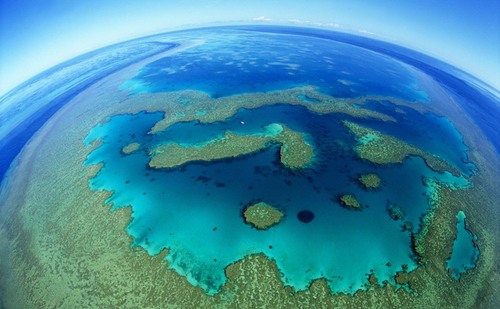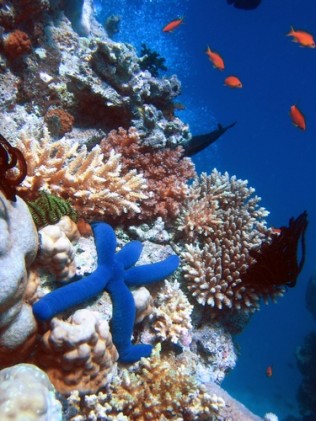
Australia’s Great Barrier Reef, one of the seven natural wonders of the world, has been marked for destruction.
Widely considered the largest coral reef system in the world, the Great Barrier Reef stretches more than 1,600 miles (2,600 kilometers) and consists of almost 3,000 separate reefs. According to the U.S. National Academy of Sciences, the reef has lost more than half of its coral since 1985, with two-thirds of the decline occurring since 1998. While much of this decline has been attributed to natural forces and climate change, the Australian Federal and State Governments are now threatening this protected area with increased industrialization, particularly port expansion related to coal mining.
On January 31, the Australian Federal Government and the Great Barrier Reef Marine Park Authority approved the expansion of Abbot Point coal port and the associated dumping of three million square meters of dredge spoil and waste into reef waters. Although the approval contains a number of safeguards, such as limits on when spoil can be dumped and compensation for adversely affected commercial fishers, environmental groups are deeply concerned for the future of the reef.
“The [Australian] Federal Government’s recent approval of large scale industrial projects close to the Great Barrier Reef flies in the face of warnings from the UN’s World Heritage Committee and could lead to the reef being placed on UNESCO’s ‘in danger’ list,” warns Don Henry, CEO of the Australian Conservation Foundation. “The approval of the Abbot Point coal port expansion will see the number of coal ships passing through the Great Barrier Reef World Heritage Area increase from 1,722 in 2011 to 10,150 by the end of this decade.”

Increased shipping means an increased risk of collisions, groundings, oil and chemical spills, new invasive marine pests and anchor damage. “You can imagine what sort of damage this dredging muck could do to [the] delicate coral ecosystem,” said Henry.
The Australian Marine Conservation Society‘s Great Barrier Reef campaign director, Felicity Wishart, is also concerned about what could potentially become a “shipping superhighway.”
“Coral reefs and seagrass meadows in parts of the reef are already in serious decline and vulnerable species such as turtles, dugongs and dolphins are doing it tough,” Wishart said. “There is still a lot of natural beauty for tourists to explore and enjoy on the reef. However, if we allow dredging, dumping and a shipping superhighway, the health of the reef and its wildlife will get worse not better.”
According to Wishart, the World Heritage Committee is so alarmed about industrial threats to the Great Barrier Reef World Heritage Area that it will consider listing the reef as “World Heritage in Danger” when it meets later this year.
“Developers want to dump millions of tonnes of dredge spoil in reef waters,” said Nick Heath, spokesman for the Fight for the Reef campaign. “We know dredge particles can be carried by winds and currents for up to 80 kilometers and can kill coral and sea grass. We can’t treat [the reef] like a dump for dredge waste.”
Heath argues that the approved port expansions and dredging programs are largely unnecessary. “There is spare capacity in Queensland’s existing ports and there are alternatives to dredging such as building longer jetties out into deeper water.”
The Fight for the Reef campaign also argues that the mega port developments will negatively impact the AUD $6 billion (approx. USD $5.3 billion) tourism industry in the area, and threaten the 60,000 jobs the region supports. “People don”t travel across the world to see bulk carriers, dredge plumes and big industrial ports,” said Heath.
Other conservation organisations agree. “Visitors want a unique natural experience on the reef, not a view of coal ports and industrial activity,” said Wishart. Marine tour operators are considering legal action against the Great Barrier Reef Marine Park Authority in response to the decision to approve dredging and dumping, the Sydney Morning Herald reports.

The Australian Conservation Foundation’s concern also extends beyond environmental impact. “While short-sighted state government decisions can certainly damage the reef itself, the economic damage will also be immense,” Henry said.
“The assessment processes for individual projects are not coping with the outstanding universal value of the reef, its beauty, its integrity, its scale—ad hoc assessment processes are just sweeping these projects through without looking at the bigger picture,” Greenpeace Senior Climate Campaigner Georgina Woods told the Sydney Morning Herald in May of last year.
The Queensland State Government ministries for environment and tourism were both approached for comment, but did not respond.
Travelers and others who are concerned about the Great Barrier Reef can get active with groups like the Australian Conservation Foundation, Greenpeace, WWF and the Australian Marine Conservation Society. Visit the Fight for the Reef website to sign up for the latest news on this developing situation and updates on ways to help protect the reef.
“A global treasure like the Great Barrier Reef needs a worldwide movement of people willing to stand up for its protection,” said Wishart. “Together the community can put pressure on governments and industry to ensure the reef is protected for the long term.”
Read Ethical Traveler's Reprint Policy.
